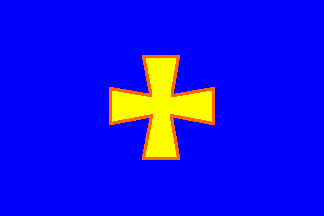 (2:3)
(2:3)image by Ivan Sache, 1 December 2000

Last modified: 2010-02-12 by dov gutterman
Keywords: ukraine | poltava |
Links: FOTW homepage |
search |
disclaimer and copyright |
write us |
mirrors
 (2:3)
(2:3)
image by Ivan Sache, 1 December 2000
See also:
Districts (Rayon):
Municipalities:
From the site of Ukrainian
Heraldry:
"The Poltavs'ka oblast' flag was approved by February 10,
2000 by the solution XI of session of regional advice XXIII of
convocation and represents the yellow cossac's cross on a blue
rectangular. A ratio of the parties is 2:3. The cossac's cross is
the basic element of the arms of the Poltavs'ka oblast' was
introduced in composition of a flag, which one is included on
historical motives. In middle of XVIII century a some cossac's
regiments were joint around of the Poltava shelf, that had dark
blue flag with cossac's cross. The author is E.Shyrai. The flag
was adopted febuary 10, 2000"
Dirk Schonberger, 28 November 2000
Poltava is a city of c. 300,000 inhabitants located south-west
of Kharkiv/Kharkov (North-East of Ukraine). On 8 July 1709, tsar
Peter the Great defeated in Poltava Charles XII, king of Sweden.
Charles XII took refuge in Ottoman Empire, tried unsuccessfully
to ally with the Sultan against Russia, and finally returned to
Sweden in 1715. Peter the Great preserved his Baltic conquests
(treaty of Nystad, 1721).
Does the cross shown on the flag have something to do with Peter
the Great?
It looks like the cross present on several military decorations
all over the world.
Ivan Sache, 1 December 2000
No, the cross have no relations with Peter I the Great.
Generally, in Ukraine Peter I is not a "favourite"
ruler. He had desbanded the Zaporozhye cosaccos, last thing of
former ukrainian semi-independence. The symbolics of
"Poltava victory", banners, swords etc, of Peter I was
on old Coat of Arms of Poltava (1803 and 1878) but not on
modern.The cross on blue field is traditional symbol of cosaccos
of Poltava Regiment. Analogous cross is a part of Coat of Arms of
towns Mirgorod and Zenkov in Poltava Oblast.
Victor Lomantsov, 2 December 2000
po1.gif)
image from the site of Ukrainian
Heraldry
po.gif)
Large Coat of Arms
image from the site of Ukrainian
Heraldry
From the site of Ukrainian
Heraldry:
"It was confirmed at January, 30, 1998. A shield divided
into quarters by raspberry lozenge, crossed by argent and azure
wavy belt. In first azure part is or paty cross. In second or
part is gules horseshoe. In third or part is gules heart. In
fourth azure part is or wheat sheaf. In first part of lozenge is
or bow, accompanied by two or stars, in second is or gates with
three towers, accompanied by two or stars.
- Bow with arrow and stars are the elements which went into
Poltava and Pyriatyn coats of arms, indicate on historic role the
edges in defence of own earths, and also Poltava as
administrative centre.
- Urban gates with three towers and flagpoles - element eldest of
coats of arms, basic Lokhvytsia coat of arms element. It
indicates on durability, power, edge inviolability, cossack
traditions.
- A water wave - element of Komsomol's'k and Kremenchuk emblems,
symbolizes riches of water spaces.
- A Cossack cross is symbol on historic colours of Poltava
regiments and Myrhorod and Zin'kiv emblems.
- A horseshoe is blown about element of patrimonial Ukraine coats
of arms - happiness symbol, good, love, consent.
- A heart is hetman coat of arms element of P.Polubotok,
V.Kochubey, symbolizes Poltavschyna as Ukraine heart, her
grandeur, spirituality, - earth, begining by mother country to
prominent figures of world significance.
- Sheaf is personifies natural resource, earths fertility,
industry of its inhabitants, national traditions.
- A Crown is power, firmness, grandeur and glory.
Adopted colours:
- Raspberry - most blown about colour of cossack colours - power,
bravery.
- Azure means wrestling after freedom, hope.
- Or means sun, lightly, welfare, kindness, work, dignity.
The large Coat of Arms is a little coat of arms crowned by crown
with five towers and enframed by guelder roze branches, entwisted
by blue-yellow ribbon. Over crown is superscription
"Poltavschyna"."
Dirk Schonberger, 28 November 2000